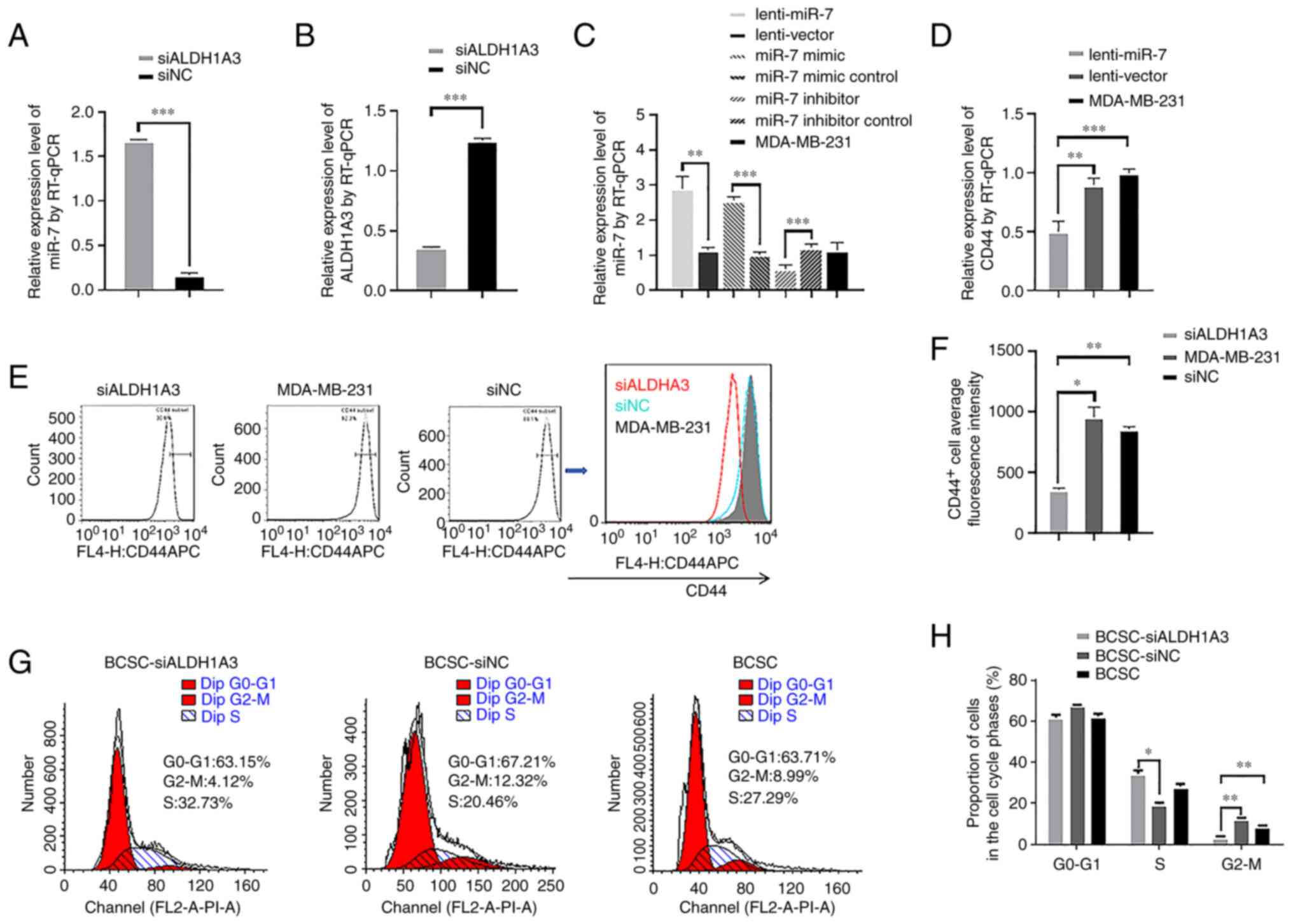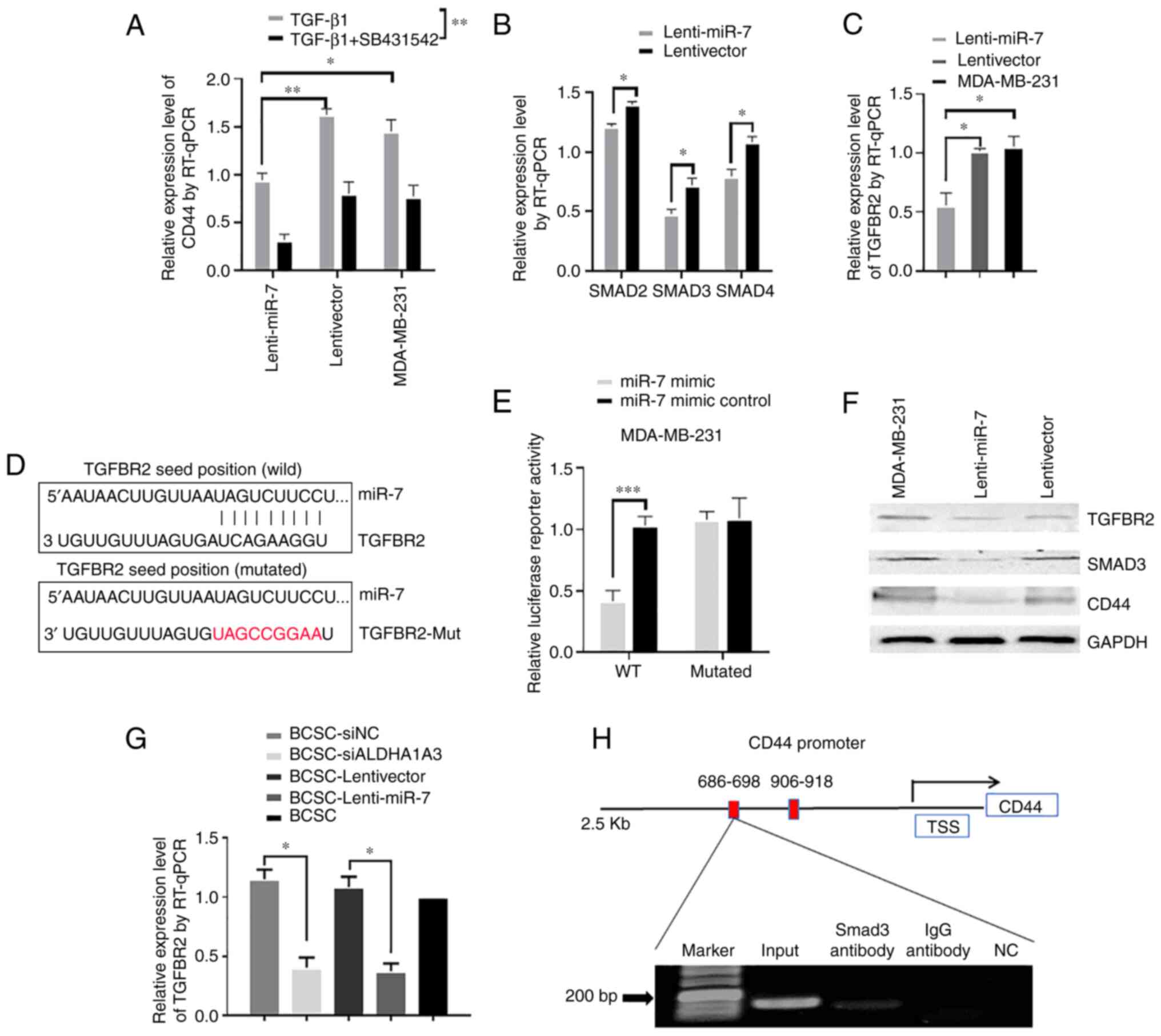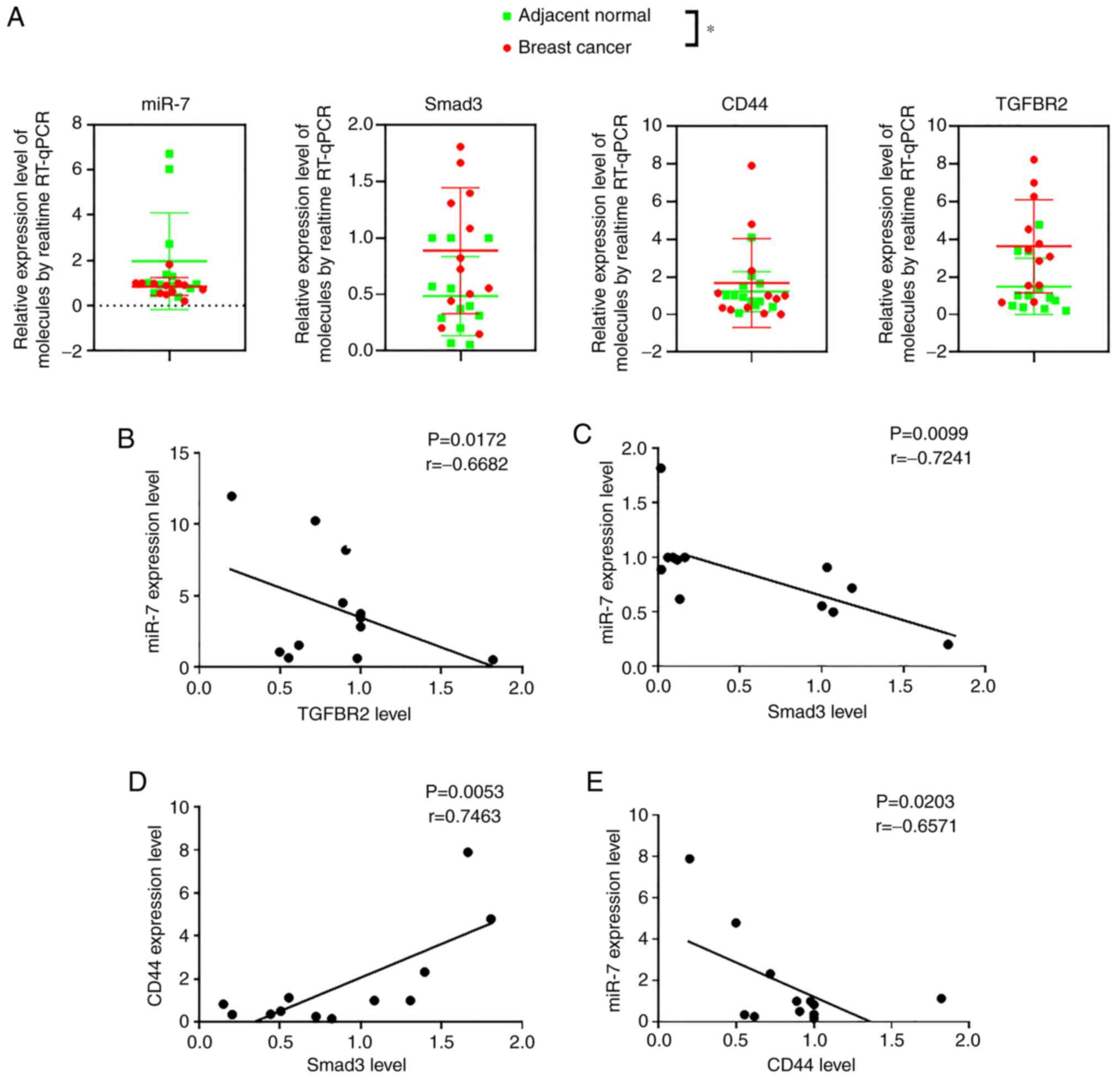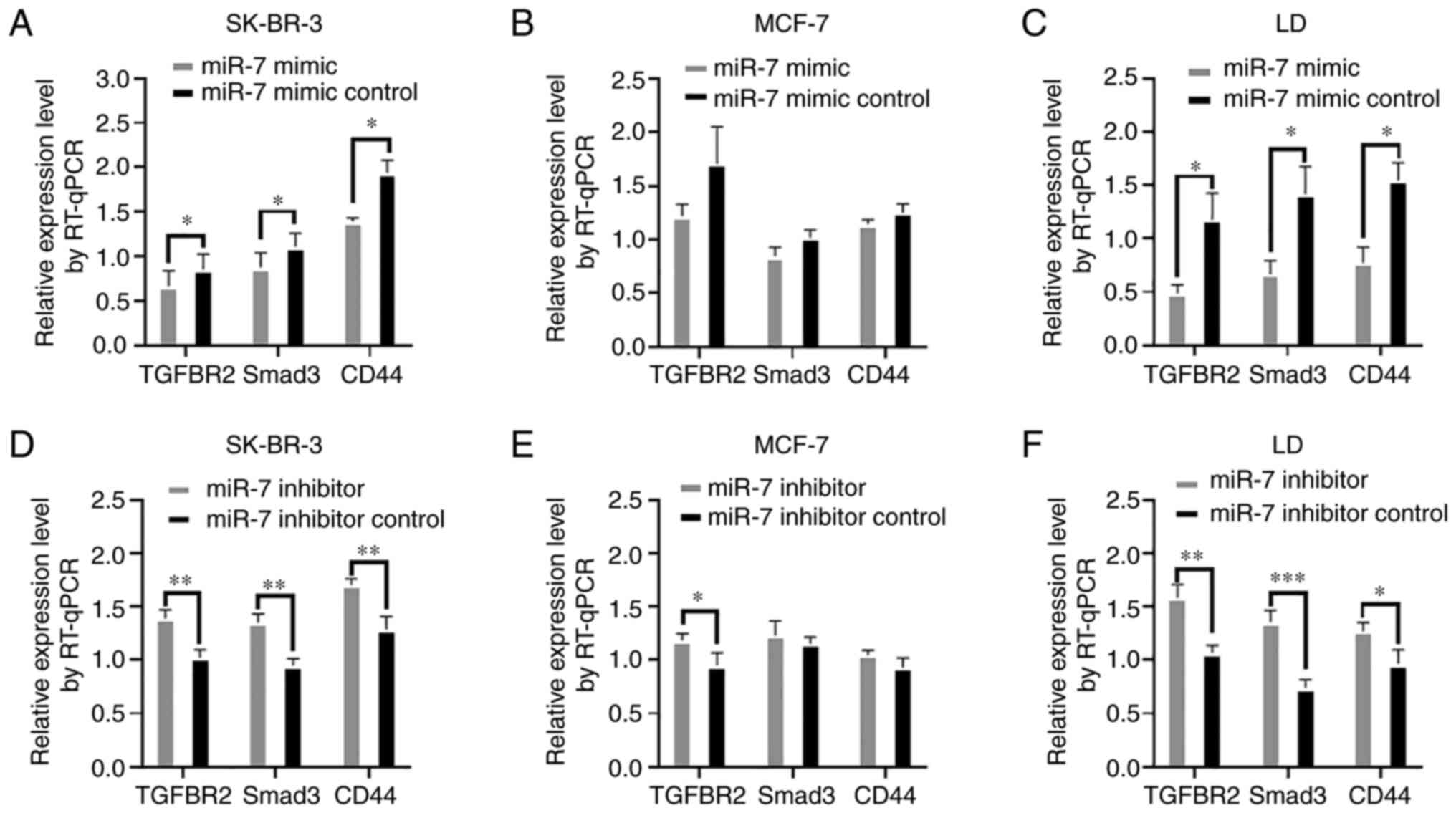|
1
|
Gonzalez-Angulo AM, Morales-Vasquez F and
Hortobagyi GN: Overview of resistance to systemic therapy in
patients with breast cancer. Adv Exp Med Biol. 608:1–22.
2007.PubMed/NCBI View Article : Google Scholar
|
|
2
|
Chaffer CL and Weinberg RA: A perspective
on cancer cell metastasis. Science. 331:1559–1564. 2011.PubMed/NCBI View Article : Google Scholar
|
|
3
|
Dou J, Li Y, Zhao F, Hu W, Wen P, Tang Q,
Chu L, Wang Y, Cao M, Jiang C and Gu N: Identification of tumor
stem-like cells in a mouse myeloma cell line. Cell Mol Biol
(Noisy-le-grand). 55 (Suppl):OL1151–OL1160. 2009.PubMed/NCBI
|
|
4
|
Bravo-Egana V, Rosero S, Molano RD,
Pileggi A, Ricordi C, Domínguez-Bendala J and Pastori RL:
Quantitative differential expression analysis reveals miR-7 as
major islet microRNA. Biochem Biophys Res Commun. 366:922–926.
2008.PubMed/NCBI View Article : Google Scholar
|
|
5
|
Junn E, Lee KW, Jeong BS, Chan TW, Im JY
and Mouradian MM: Repression of alpha-synuclein expression and
toxicity by microRNA-7. Proc Natl Acad Sci USA. 106:13052–13057.
2009.PubMed/NCBI View Article : Google Scholar
|
|
6
|
Li X and Carthew RW: A microRNA mediates
EGF receptor signaling and promotes photoreceptor differentiation
in the Drosophila eye. Cell. 123:1267–1277. 2005.PubMed/NCBI View Article : Google Scholar
|
|
7
|
Zhang H, Cai K, Wang J, Wang X, Cheng K,
Shi F, Jiang L, Zhang Y and Dou J: miR-7, inhibited indirectly by
lincRNA HOTAIR, directly inhibits SETDB1 and reverses the EMT of
breast cancer stem cells by downregulating the STAT3 pathway. Stem
Cells. 32:2858–2868. 2014.PubMed/NCBI View Article : Google Scholar
|
|
8
|
Li M, Pan M, You C, Zhao F, Wu D, Guo M,
Xu H, Shi F, Zheng D and Dou J: miR-7 reduces the BCSC subset by
inhibiting XIST to modulate the miR-92b/Slug/ESA axis and inhibit
tumor growth. Breast Cancer Res. 22(26)2020.PubMed/NCBI View Article : Google Scholar
|
|
9
|
Pan M, Li M, You C, Zhao F, Guo M, Xu H,
Li L, Wang L and Dou J: Inhibition of breast cancer growth via
miR-7 suppressing ALDH1A3 activity concomitant with decreasing
breast cancer stem cell subpopulation. J Cell Physiol.
235:1405–1416. 2020.PubMed/NCBI View Article : Google Scholar
|
|
10
|
Livak KJ and Schmittgen TD: Analysis of
relative gene expression data using real-time quantitative PCR and
the 2(-Delta Delta C(T)) method. Methods. 25:402–408.
2001.PubMed/NCBI View Article : Google Scholar
|
|
11
|
Mon-López D and Tejero-González CM:
Validity and reliability of the TargetScan ISSF Pistol & Rifle
application for measuring shooting performance. Scand J Med Sci
Sports. 29:1707–1712. 2019.PubMed/NCBI View Article : Google Scholar
|
|
12
|
Dou J, Wang Y, Yu F, Yang H, Wang J, He X,
Xu W, Chen J and Hu K: Protection against Mycobacterium
tuberculosis challenge in mice by DNA vaccine
Ag85A-ESAT-6-IL-21 priming and BCG boosting. Int J Immunogenet.
39:183–190. 2012.PubMed/NCBI View Article : Google Scholar
|
|
13
|
Cibi DM, Mia MM, Guna Shekeran S, Yun LS,
Sandireddy R, Gupta P, Hota M, Sun L, Ghosh S and Singh MK: Neural
crest-specific deletion of Rbfox2 in mice leads to craniofacial
abnormalities including cleft palate. Elife.
8(e45418)2019.PubMed/NCBI View Article : Google Scholar
|
|
14
|
Fornes O, Castro-Mondragon JA, Khan A, van
der Lee R, Zhang X, Richmond PA, Modi BP, Correard S, Gheorghe M,
Baranašić D, et al: JASPAR 2020: Update of the open-access database
of transcription factor binding profiles. Nucleic Acids Res. 48
(D1):D87–D92. 2020.PubMed/NCBI View Article : Google Scholar
|
|
15
|
Khan A, Fornes O, Stigliani A, Gheorghe M,
Castro-Mondragon JA, van der Lee R, Bessy A, Chèneby J, Kulkarni
SR, Tan G, et al: JASPAR 2018: Update of the open-access database
of transcription factor binding profiles and its web framework.
Nucleic Acids Res. 46 (D1):D260–D266. 2018.PubMed/NCBI View Article : Google Scholar
|
|
16
|
Kawakami R, Mashima T, Kawata N, Kumagai
K, Migita T, Sano T, Mizunuma N, Yamaguchi K and Seimiya H:
ALDH1A3-mTOR axis as a therapeutic target for anticancer
drug-tolerant persister cells in gastric cancer. Cancer Sci.
111:962–973. 2020.PubMed/NCBI View Article : Google Scholar
|
|
17
|
Yamashita D, Minata M, Ibrahim AN,
Yamaguchi S, Coviello V, Bernstock JD, Harada S, Cerione RA,
Tannous BA, La Motta C, et al: Identification of ALDH1A3 as a
viable therapeutic target in breast cancer metastasis-initiating
cells. Mol Cancer Ther. 19:1134–1147. 2020.PubMed/NCBI View Article : Google Scholar
|
|
18
|
Wang S, Zhou X, Liang C, Bao M, Tian Y,
Zhu J, Zhang T, Yang J and Wang Z: ALDH1A3 serves as a predictor
for castration resistance in prostate cancer patients. BMC Cancer.
20(387)2020.PubMed/NCBI View Article : Google Scholar
|
|
19
|
Al-Hajj M, Wicha MS, Benito-Hernandez A,
Morrison SJ and Clarke MF: Prospective identification of
tumorigenic breast cancer cells. Proc Natl Acad Sci USA.
100:3983–3988. 2003.PubMed/NCBI View Article : Google Scholar : Erratum in: Proc
Natl Acad Sci USA 100: 6890, 2003.
|
|
20
|
Fillmore C and Kuperwasser C: Human breast
cancer stem cell markers CD44 and CD24: Enriching for cells with
functional properties in mice or in man? Breast Cancer Res.
9(303)2007.PubMed/NCBI View
Article : Google Scholar
|
|
21
|
Zhao P, Xu Y, Wei Y, Qiu Q, Chew TL, Kang
Y and Cheng C: The CD44s splice isoform is a central mediator for
invadopodia activity. J Cell Sci. 129:1355–1365. 2016.PubMed/NCBI View Article : Google Scholar
|
|
22
|
Zhang H, Brown RL, Wei Y, Zhao P, Liu S,
Liu X, Deng Y, Hu X, Zhang J, Gao XD, et al: CD44 splice isoform
switching determines breast cancer stem cell state. Genes Dev.
33:166–179. 2019.PubMed/NCBI View Article : Google Scholar
|
|
23
|
Sun C, Sun L, Jiang K, Gao DM, Kang XN,
Wang C, Zhang S, Huang S, Qin X, Li Y, et al: NANOG promotes liver
cancer cell invasion by inducing epithelial-mesenchymal transition
through NODAL/SMAD3 signaling pathway. Int J Biochem Cell Biol.
45:1099–1108. 2013.PubMed/NCBI View Article : Google Scholar : Erratum in: Int J
Biochem Cell Biol 105: 144, 2018.
|
|
24
|
Itatani Y, Kawada K and Sakai Y:
Transforming growth factor-β signaling pathway in colorectal cancer
and its tumor microenvironment. Int J Mol Sci.
20(E5822)2019.PubMed/NCBI View Article : Google Scholar
|
|
25
|
Vitiello GAF, Amarante MK, Banin-Hirata
BK, Campos CZ, de Oliveira KB, Losi-Guembarovski R and Watanabe
MAE: Transforming growth factor beta receptor II (TGFBR2) promoter
region polymorphism in Brazilian breast cancer patients:
Association with susceptibility, clinicopathological features, and
interaction with TGFB1 haplotypes. Breast Cancer Res Treat.
178:207–219. 2019.PubMed/NCBI View Article : Google Scholar
|
|
26
|
Kumar R, Conklin DS and Mittal V:
High-throughput selection of effective RNAi probes for gene
silencing. Genome Res. 13:2333–2340. 2003.PubMed/NCBI View Article : Google Scholar
|
|
27
|
Zhao L and Zhang Y and Zhang Y: Long
noncoding RNA CASC2 regulates hepatocellular carcinoma cell
oncogenesis through miR-362-5p/Nf-κB axis. J Cell Physiol.
233:6661–6670. 2018.PubMed/NCBI View Article : Google Scholar
|
|
28
|
Xie X, Lu J, Kulbokas EJ, Golub TR, Mootha
V, Lindblad-Toh K, Lander ES and Kellis M: Systematic discovery of
regulatory motifs in human promoters and 3' UTRs by comparison of
several mammals. Nature. 434:338–345. 2005.PubMed/NCBI View Article : Google Scholar
|


















